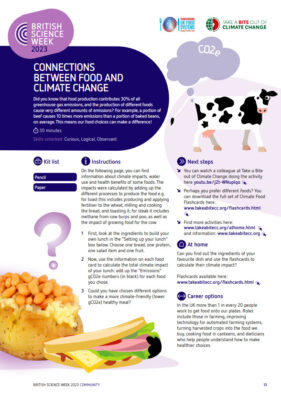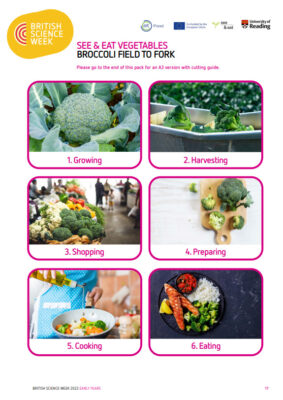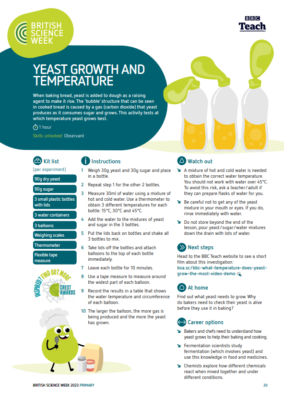Food, as they say, is the great leveller.
We all need to eat, whether we lean towards savoury or sweet, quick and easy or a labour of love, eating is ever-present.
Choosing, sourcing and cooking food might not seem to be a particularly scientific process, but like so many everyday parts of life, science is beavering away in the background.
Where our food comes from – the farm to fork journey, the cooking process (what makes bread rise?!) and the impacts of our culinary choices on the environment all have scientific foundation, which is why food is a topic that runs through all of this year’s British Science Week activity packs.
Each of the three education packs, designed for children and young people aged under 5 to 14, and the Community pack for all ages, has an activity or two where our connection to food is the star.
Early years – See and eat vegetables
As small children start to discover the big wide world of food and develop their own tastes, it’s the perfect time to start teaching them how their dinner arrives on the plate.
‘See and eat vegetables!’ in the Early Years activity pack, created in partnership with the University of Reading, takes children on a broccoli’s journey from being grown to ending up in their bellies. The activity comes with pictures that can be printed of and used to make a storyboard to demonstrate each stage of the broccoli’s adventure, including harvesting and preparing.
Early years are an incredibly important time in educational development; children start to formulate world views and interests from a very young age. Getting little ones engaged with what they’re eating and where it comes from could build a foundation for sound food choices as they grow.
Primary – Yeast growth and temperature
Baking bread is a brilliant way to get primary school-aged children involved with cooking, it’s fun, messy and has delicious results.
It’s also a fantastic opportunity to show children that science is all around us, including the kitchen! How heavy, gluey dough rises and transforms into light and fluffy bread is an especially good for investigating the chemistry of cooking.
In the Primary activity pack you’ll find ‘Yeast growth and temperature’, created in partnership with BBC Teach. This activity requires a few kitchen basics, and has young chefs discovering how yeast reacts with sugar and water to grow, which is what makes bread rise!
Secondary and Community – Connections between food and climate change
 For young people, making informed decisions about what they eat is one of the first steps on the path to being an independent grown-up, and a big part of everyday life for adults. Food choices have lots of implications for our health and wellbeing, and of course for the environment.
For young people, making informed decisions about what they eat is one of the first steps on the path to being an independent grown-up, and a big part of everyday life for adults. Food choices have lots of implications for our health and wellbeing, and of course for the environment.
As the climate crisis intensifies, it’s important for people for all ages to understand the different levels of carbon emissions attached to foods.
Which is why you’ll find ‘Connections between food and climate change’, created in partnership with Take a Bite out of Climate Change, in both the Secondary and Community packs.
This activity has participants building a meal using the provided food cards, which show the emissions and nutritional values of different foods. A cheese and tomato sandwich or beans on toast followed by some strawberries, which is better for the environment? Run the activity to find out!
British Science Week, as well as being celebration of science, technology, engineering and maths, is a chance to explore the things that connect us to each other and to the world, and nothing fits that bill more than food.

